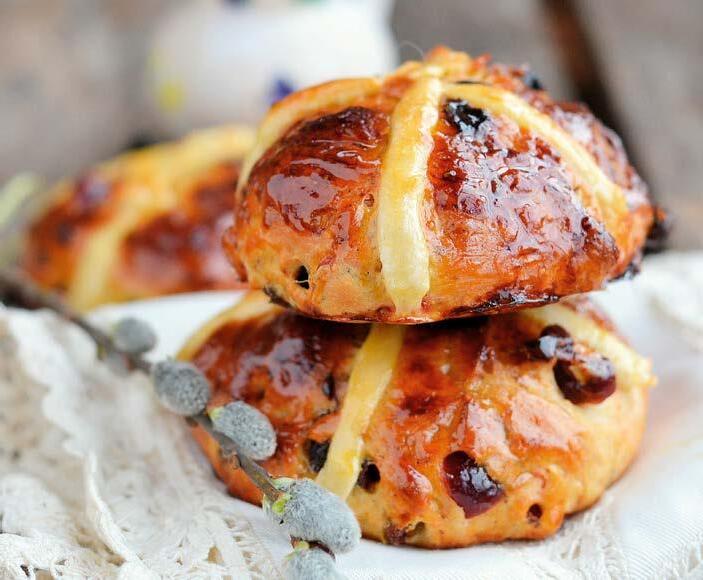



















































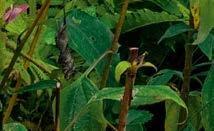



Good design can be playful as well as beautiful and a sense of fun permeates this small but multi-layered Clapham garden, created by Filippo Dester, with its basement slide, bespoke playhouse and a focus on dense planting and views


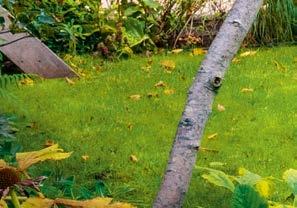

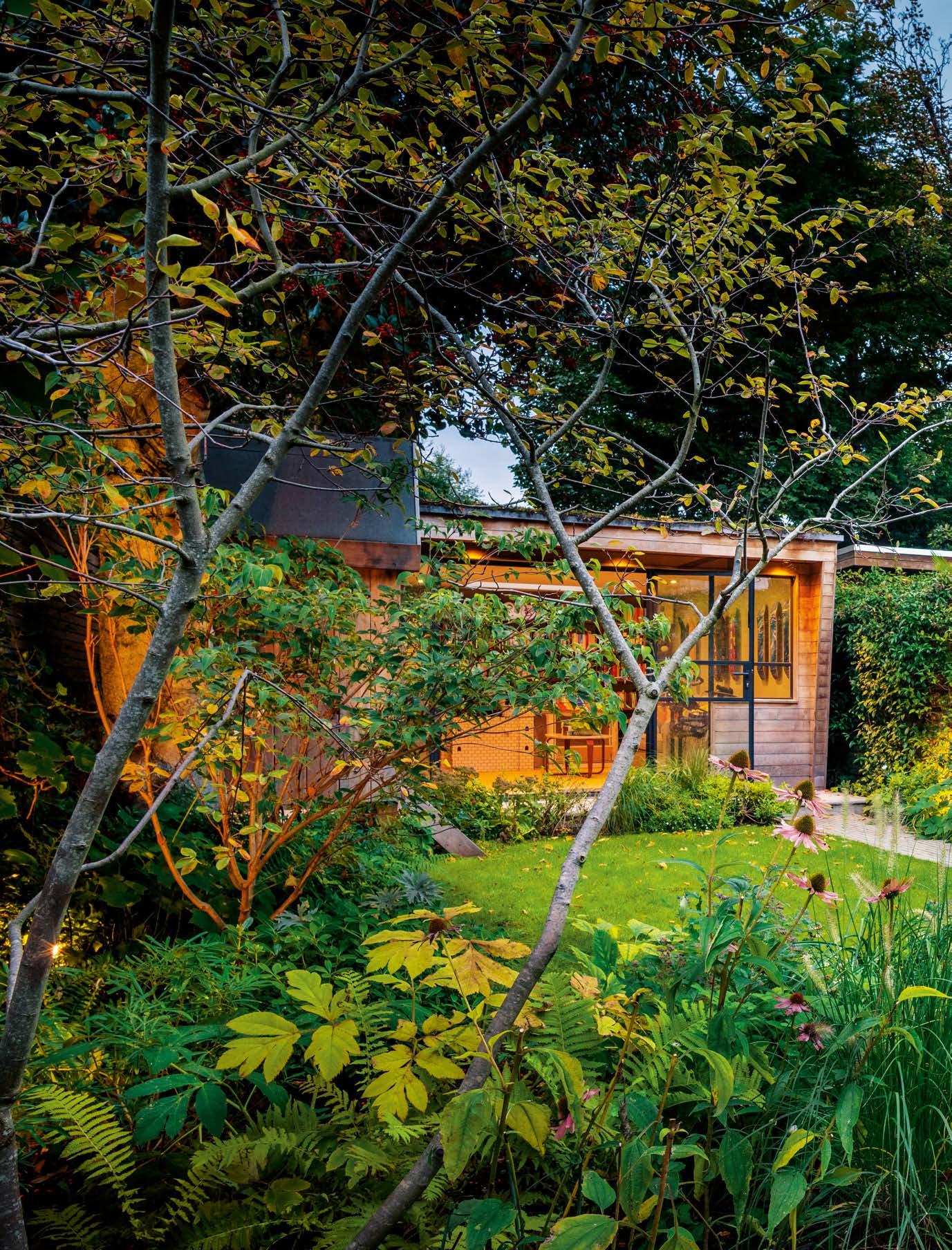
It’s only 6.5m x 25m, but every inch of this London garden has been maximised to allow abundant planting and superb layered views.

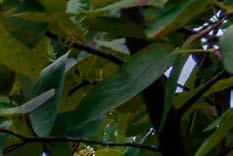
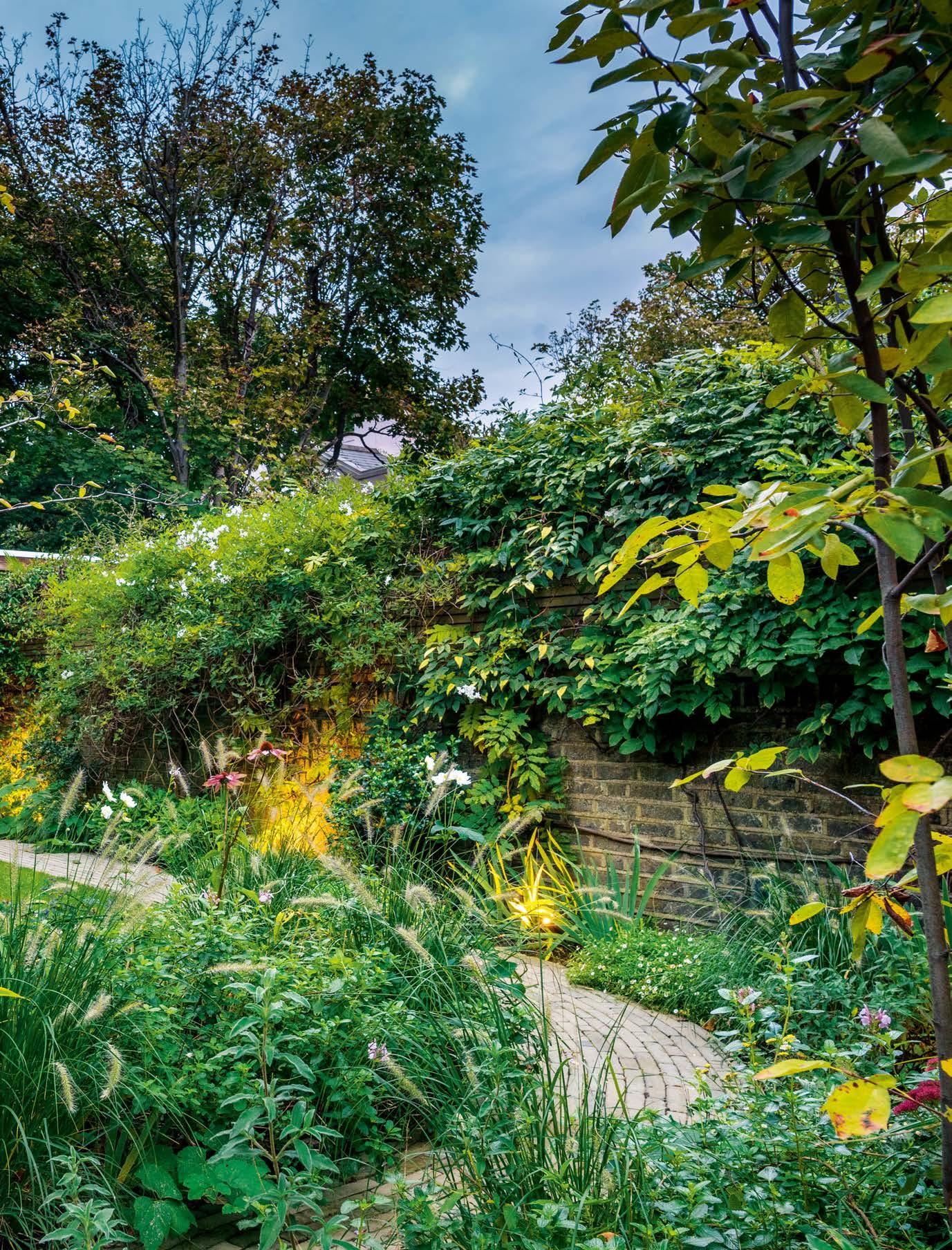
Despite being just six miles south-west of Edinburgh city centre, Riccarton Mains House enjoys a surprisingly rural location amid open fields and woodland. Its terraced garden, packed with colour and studded with topiary and mature trees, slopes up from the back of the house in the direction of the nearby Pentland Hills.
Although it has the quiet air of a place that has always been there, both the house and garden have in fact been developed over the past 50 years by Vicki and Michael Reid-Thomas, who bought the plot of land when it was home only to several derelict farm buildings. Creating the garden from scratch was a project that the couple embraced, but the site’s exposed location initially presented a challenge when it came to establishing plants. “When we arrived here there were just three trees – two sycamores and an ash,” Vicki recalls. “The position used to drive me nuts to begin with, because when you’re surrounded by open farmland there’s nothing between you and the wind driving across the fields.”

Their first major task was to add shelter to filter the prevailing wind by planting a belt of trees that today forms the mixed woodland surrounding the house. Beech and hawthorn hedges add further protection and define the garden’s boundary. Once these essential elements were in place, laying out and
Right Billowing pastel planting on the terrace bank behind the house includes saxifrage, Salvia nemorosa and valerian.
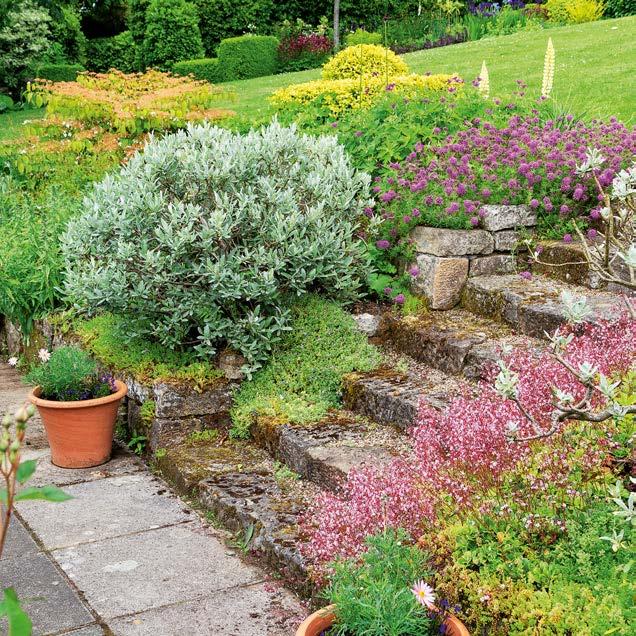

Bottom right Allium ‘Mont Blanc’ in the shade below a sorbus tree.

Bottom left A mound of silvery clipped Swiss willow sits alongside the steps to the first terrace.
Below Michael ReidThomas, who owns Riccarton with wife Vicki.
planting the garden could begin, but remarkably, neither Vicki nor Michael had any knowledge of gardening at the outset. “Quite honestly I didn’t really know the di erence between a shrub and a tree,” Vicki admits. “I took advice from an elderly relative, read gardening articles and went on courses, and I have had professional help from garden designers over the years, which has been invaluable.”
Designer Kate Hawkins was instrumental in laying out the garden’s first terrace, which is at the same level as the first floor of the house. The sunny bed that slopes up towards the lawn along the length of this terrace is brimming with a glorious cottage garden-style mixture of billowing perennials, grasses, topiary and floriferous roses. The topiary, including box and holly, was added about 20 years ago at the suggestion of garden designer Wendy Wright to bring structure and symmetry that would create a framework for Vicki to plant around. Silvery mounds of clipped Swiss willow (Salix helvetica) also flank the central steps and have just been
“When you’re surrounded by open farmland there’s nothing between you and the wind”
replaced after 30 years. They combine perfectly with the surrounding herbaceous planting, where the slender, dark purple flower spikes of Salvia x superba ‘East Friesland’ and cloud-like clusters of white valerian (Centranthus ruber ‘Albus’) rise up through drifts of vibrant pink Geranium ‘Patricia’, which is a favourite of Vicki’s thanks to its long flowering season. “I tend to do a Chelsea chop on half of it to get more flowers later in the season as well,” she explains.
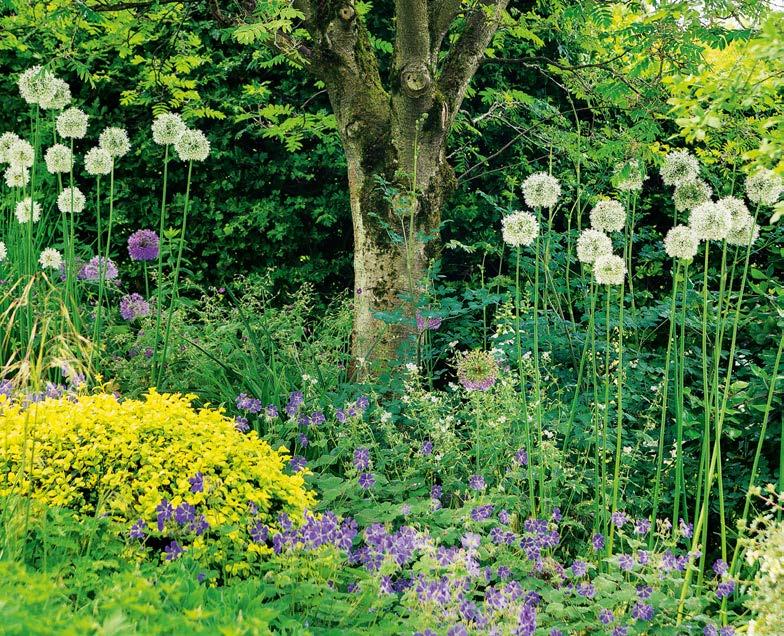
Delicate vertical accents are also provided by white foxgloves, which Vicki calls the garden’s ‘signature’, since they are allowed to seed around and flower whenever they fall in a favourable spot. Many can be found at the terrace’s eastern end in the shade of a mountain ash (Sorbus aucuparia), which was one of the first trees Vicki planted. A host of other white-flowered bulbs and perennials
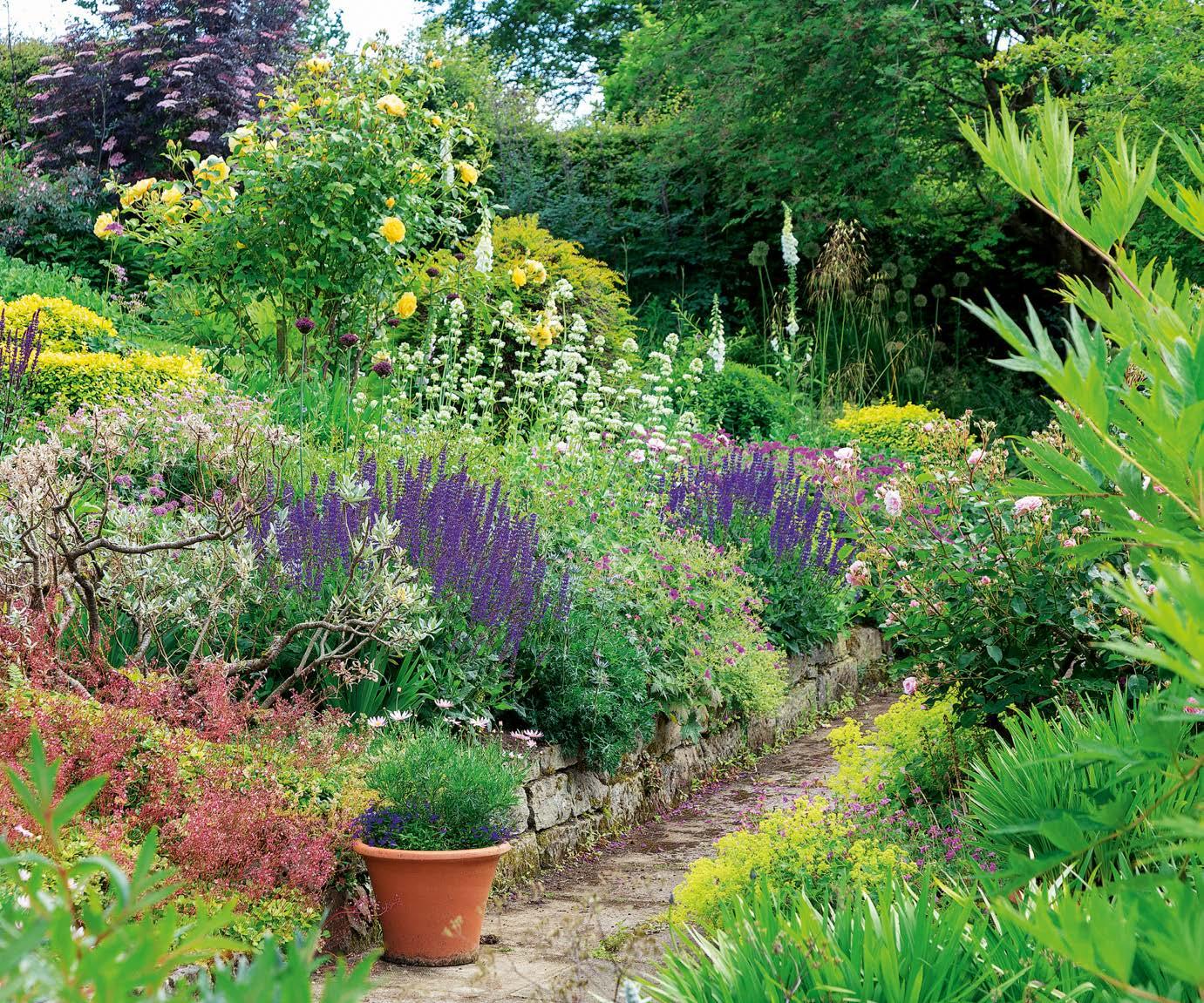


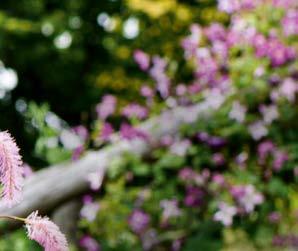

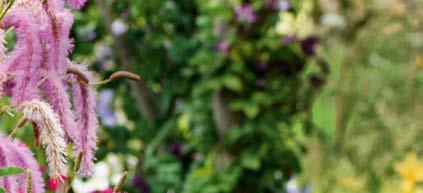
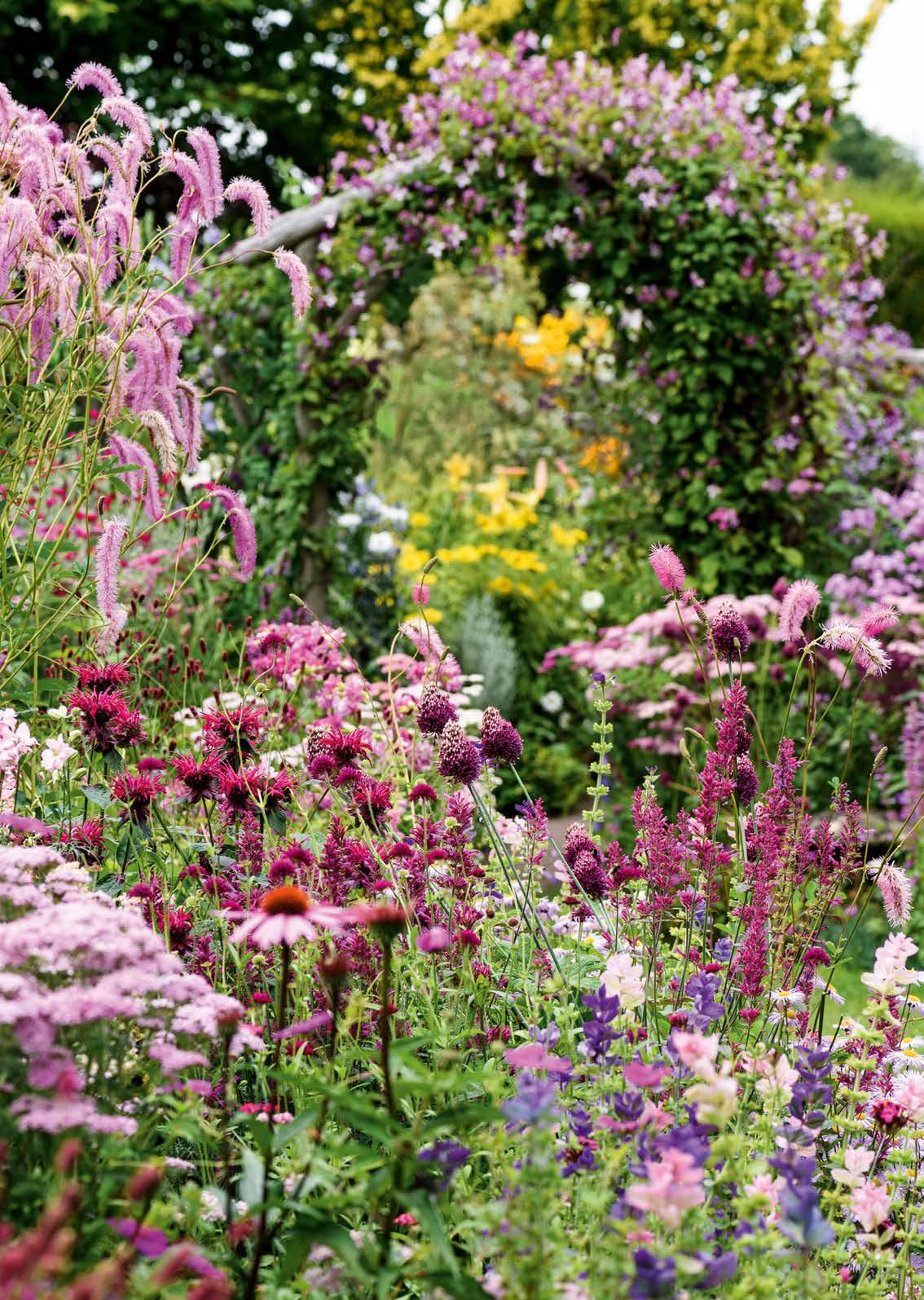
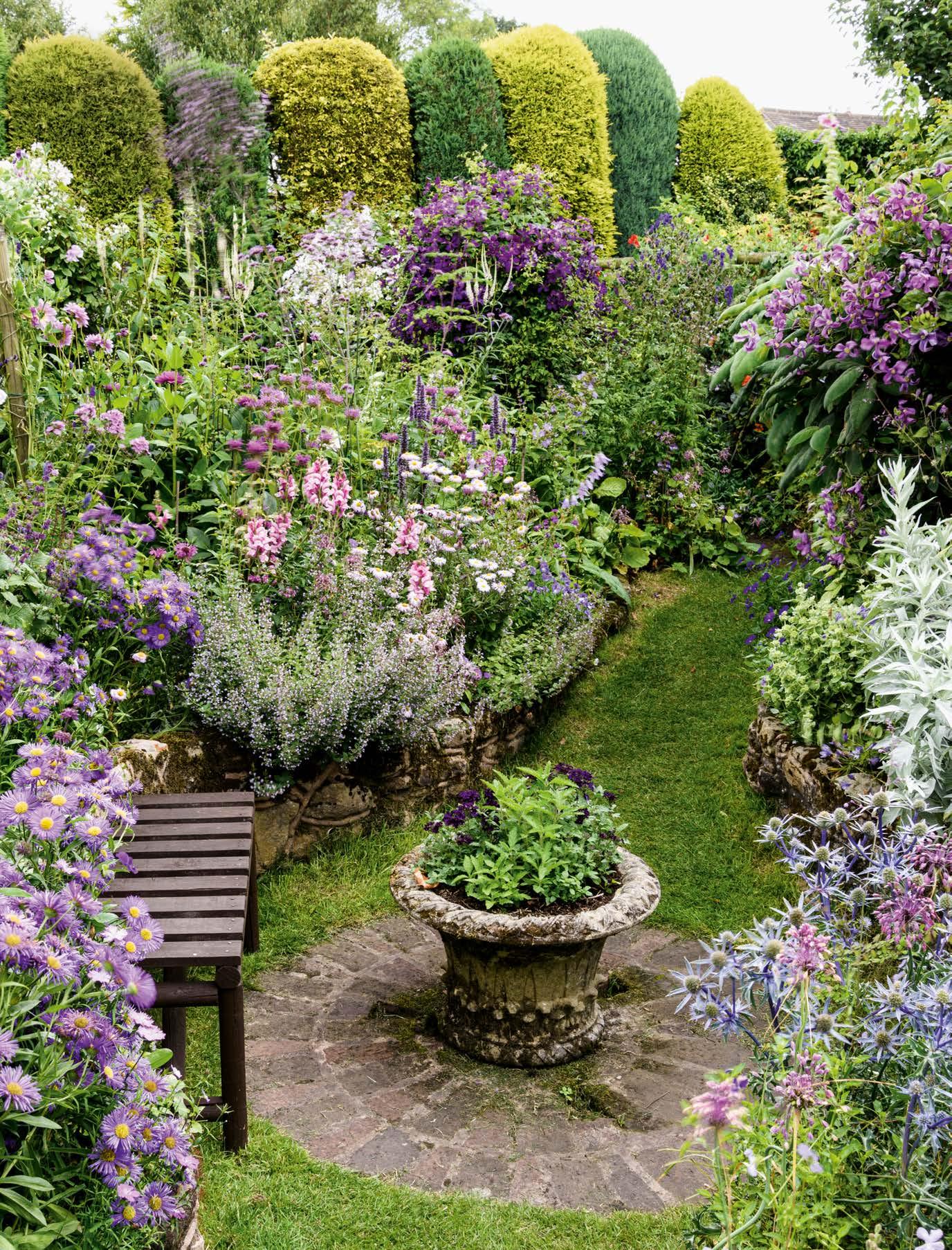
 Opposite Sanguisorba, monarda and echinacea in one of Grafton Cottage’s colour-themed borders. This image An urn of purple verbena sits at the centre of a sunken area.
Opposite Sanguisorba, monarda and echinacea in one of Grafton Cottage’s colour-themed borders. This image An urn of purple verbena sits at the centre of a sunken area.
Little is as evocative in spring as the fragrance of lilac blossom. Even if these shrubs didn’t carry such a powerfully sweet, heady scent, they would still be a spectacle, adorned with such an abundance of flowers at this time of year, their branches dripping with heavy panicles.
Lilacs are seen as a little old-fashioned –something your grandmother might have grown, perhaps – but there’s nothing wrong with a little romantic nostalgia. After all, we’re living in a time when ‘Grandmacore’ is trending on TikTok. The ‘lifestyle trend’ of the moment embraces all things traditional in a bid to foster a sense of cosiness and
security that harks back to memories of visiting grandparents – not all that surprising given the turmoil of the past couple of years. So planting an old-fashioned lilac could actually be a very on-trend thing to do!
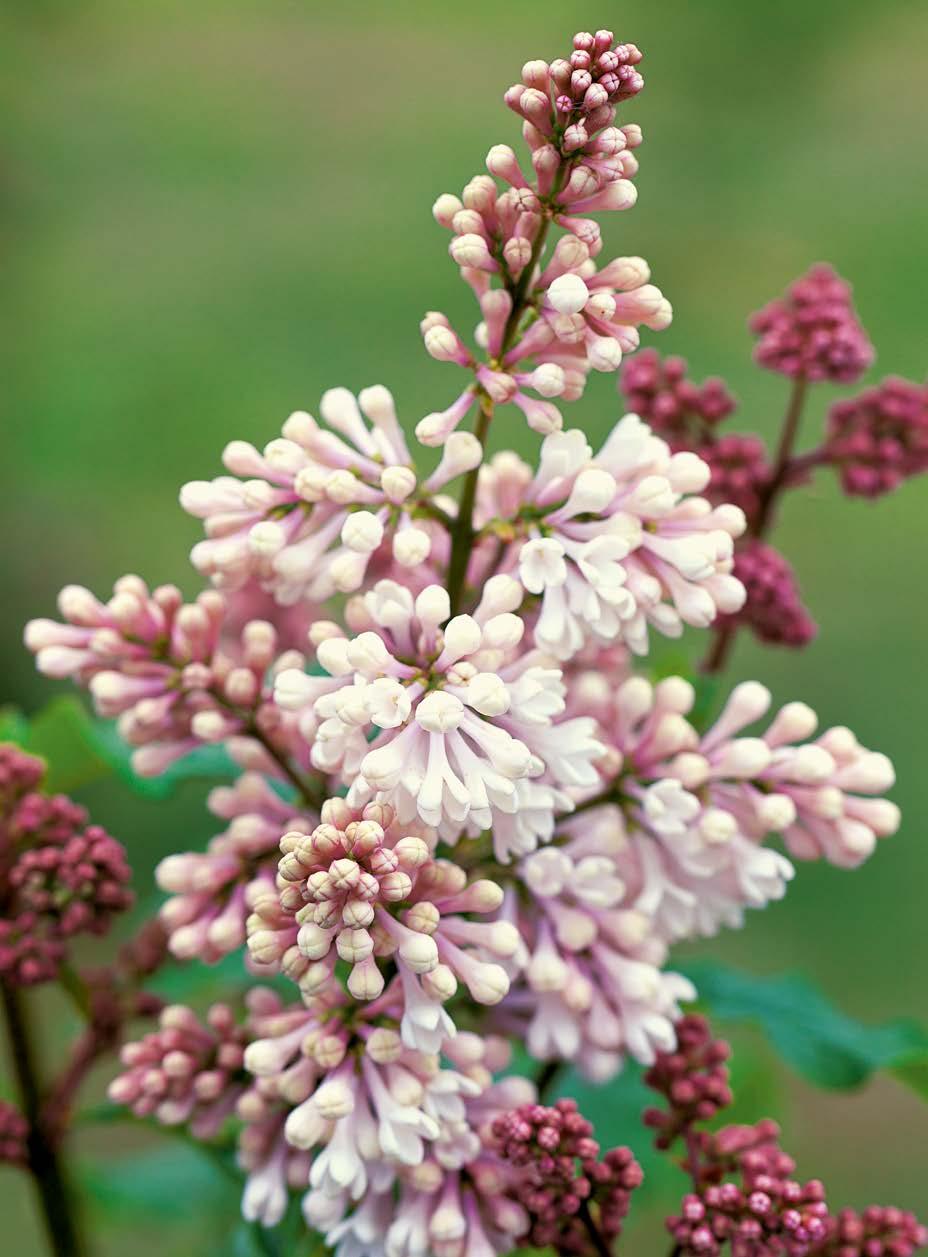
Victor Lemoine would no doubt be scratching his head at the thought of TikTok or trends. The industrious French nurseryman and plant breeder was responsible for introducing some 200 new lilac cultivars, vastly increasing the choice available to late-19th-century gardeners, and for producing the first double-flowered varieties.
Of the flurry of new cultivars bred by Lemoine, many have weathered all the trends to become time-tested stalwarts. Double white flowered Syringa vulgaris ‘Madame Lemoine’, named by Victor in 1890 after his wife (who did a lot of the fiddly cross-pollination his breeding work required), is still available today.
Popular ‘Charles Joly’, also double flowered but this time in a deep reddish-purple shade, is another of Lemoine’s prized varieties.
Modern breeding has added to the range available, and now there’s ample choice – certainly enough to make picking just one quite a tricky task. With his wife Christine, Gordon Link runs The Gobbett Nursery in Shropshire, which specialises in lilacs, along with other flowering trees and shrubs, and carries one of the UK’s largest selections of Syringa. But choosing is easy, Gordon says: simply pick one you like with a flower colour that appeals. “You can say ‘that’s a good variety’ about so many of them,” he observes. “There’s no need to narrow down your choice because generally, they’ll all do well.”
It’s true that lilacs are an undemanding, easy shrub to grow, rarely bothered by pests or problems. The only pitfall is that some can grow to be quite large, even becoming small trees, and while they don’t mind being pruned, they’ll never look as good as they would in ample space. If there isn’t much room available, Gordon advises looking away from Syringa vulgaris to other, smaller species. At its largest, slow-growing S. meyeri ‘Palibin’ will reach just 1.5m, with round green leaves and fragrant blue-pink flowers in spring. Syringa pubescens subsp. patula ‘Miss Kim’ forms a compact 2m
Above left ‘Sensation’ is notable for its distinctive, bicoloured flowers, the petals edged with white.

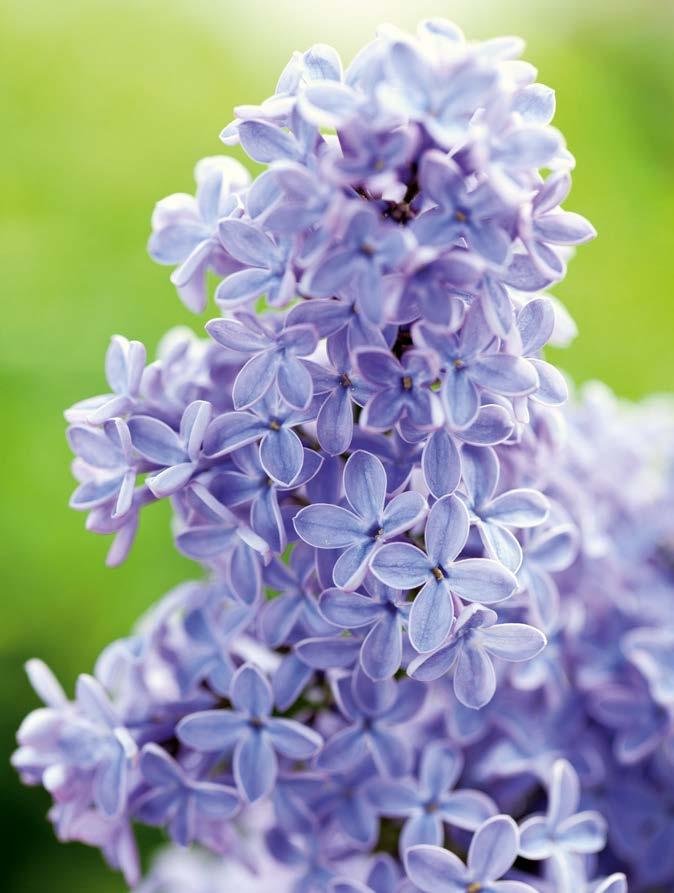
Above right One of the best for blue flowers, ‘President Lincoln’.
Below right ‘Andenken an Ludwig Späth’ has reddish-purple heavily scented flowers.

Below left ‘Primrose’ is a pale yellow in bud, opening out to clotted cream-coloured flowers.
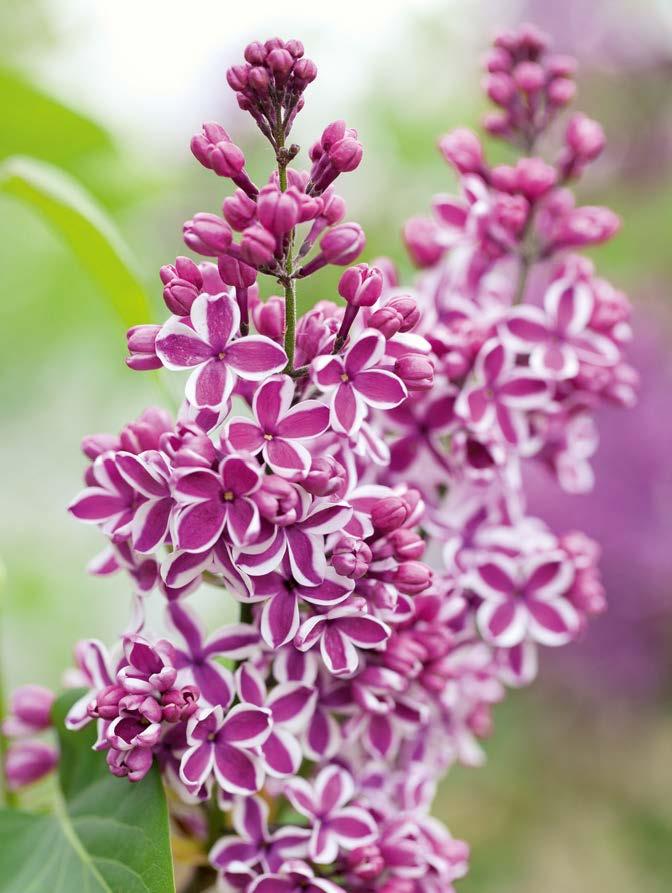
Any special occasion can be made all the more memorable with the addition of thoughtful handmade touches. Decorate personalised place cards for the Easter table with the motifs of the season using Cambridge Imprint’s Easter Printing Block Set (cambridgeimprint. co.uk). This set of eight easy-to-use printing blocks will depict patterned eggs, a speckled hen, a chick and a dancing hare. The blocks could also be used to make pretty greetings cards or even your own wrapping paper.
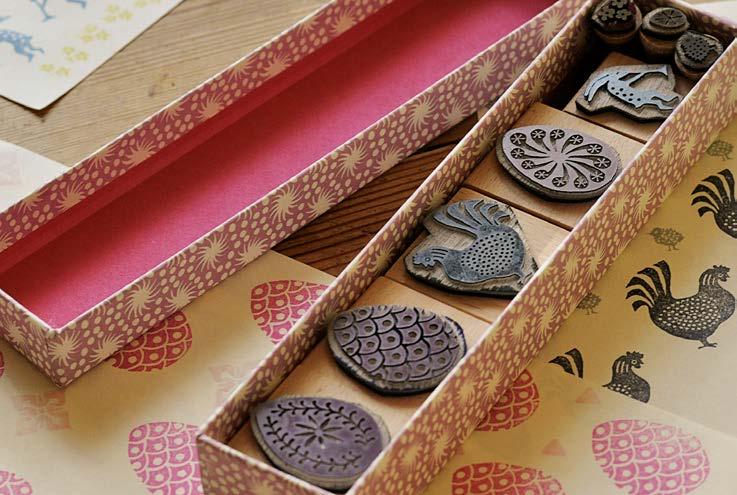
Alternatively, try your hand at potato printing, à la Molly Mahon, who often uses leftover tester pots of emulsion or chalk paint for truly budget-conscious crafting. Cut up old sheets or pillowcases and turn them into block-printed napkins using the same technique, setting the paint in place with a hot iron so the fabric can be washed. Visit mollymahon.com for inspiration.
Make temporary displays of spring-flowering bulbs and bedding plants by transforming them into pretty kokedama. These ones, created by gardener and author Kathy Brown (kathybrownsgarden.com), use clumps of muscari, which you can lift from the garden or buy in small pots at this time of year. Take a handful of damp compost and shape it into a ball around the plants’ roots, then wrap the ball in a sheet of moss, either lifted from the lawn or bought from a florist. Use a long length of string to work your way around the ball securing the moss in place.
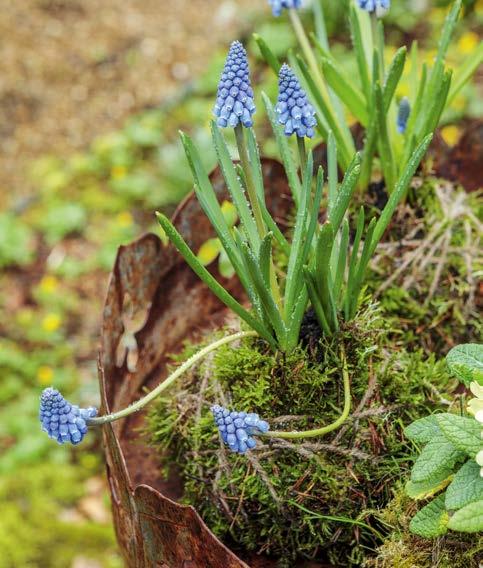
Kokedama look especially charming when displayed in groups on tables or plant stands in the garden, or on a tray indoors. Let them stand in water periodically so the root ball can soak up water. Once the flowers begin to fade, replant the bulbs in the garden.
Substantial, sticky and laced with spice, home-made hot cross buns take some beating. Like most yeast bakes they’re fairly simple, but they do need time. To enjoy them on Good Friday in the traditional way, start them on Thursday evening. Plump up the fruit in hot water before adding it to the dough. Cover the dough and leave it in the fridge to rise slowly overnight – the cold will keep the yeast in check. In the morning, shape the buns and place them in a warm spot like an airing cupboard until they double in size. At this point, add the flour-and-water crosses that distinguish them from Bath and Chelsea buns and brush them with milk. Bake them in the oven at 200°C for 20 minutes, apply a sugar-syrup glaze while they’re hot and then leave to cool.
